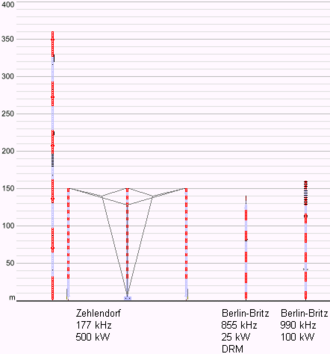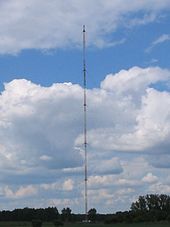Zehlendorf transmitter
|
Zehlendorf transmitter
|
|||||||||||||||||
|---|---|---|---|---|---|---|---|---|---|---|---|---|---|---|---|---|---|
| Basic data | |||||||||||||||||
| Place: | Zehlendorf ( Oranienburg ) | ||||||||||||||||
| Country: | Brandenburg | ||||||||||||||||
| Country: | Germany | ||||||||||||||||
| Altitude : | 46 m above sea level NHN | ||||||||||||||||
| Coordinates: 52 ° 47 ′ 41.7 ″ N , 13 ° 23 ′ 9.4 ″ E | |||||||||||||||||
| Use: | Broadcasting station | ||||||||||||||||
| Owner : | Media broadcast | ||||||||||||||||
| Demolition : | March 25, 2017 | ||||||||||||||||
| Data on the transmission system | |||||||||||||||||
|
|||||||||||||||||
| Last modification (transmitter) : | August 2005 | ||||||||||||||||
| Wavebands : | LW stations , AM stations , FM stations | ||||||||||||||||
| Radio : | LW broadcast , MW broadcast , VHF broadcast | ||||||||||||||||
| Send type: | DRM | ||||||||||||||||
| Shutdown : | 2017 | ||||||||||||||||
|
|||||||||||||||||
| Position map | |||||||||||||||||
|
|
|||||||||||||||||
The transmitter Zehlendorf was a radio facility in Zehlendorf , a district of Oranienburg , which was just 35 km north of Berlin as the crow flies. The system consisted of recently inactive transmission devices for broadcasting radio programs over different wave ranges or frequency bands. The long-wave broadcasting facility, which was shut down in December 2014 , was one of the most powerful of its kind in Europe. The owner was Media Broadcast GmbH . The last remaining transmitter mast was blown up on March 25, 2017 at 2 p.m.
history


Zehlendorf has been the location of broadcasting facilities since 1936. At that time, on the occasion of the 1936 Summer Olympics in Zehlendorf, a shortwave transmission system was set up for the fixed radio service. This system, which until the end of World War II was known as the " Rehmate radio station ", had 26 different antennas. In 1945 the Rehmate radio station was dismantled by the Soviet occupying forces as a reparation payment - except for three wooden antenna supports. Two of the antenna supports that had not been dismantled supplied the building material for the 100 meter high transmission tower of the Golm transmitter in Golm , which was built in 1948 and demolished in 1979.
In 1952 it was decided to build the central long-wave transmitter of the GDR on the site of the former Rehmate radio station. The transmitter was put into operation in 1955. Between 1956 and 1958, a triangular antenna was installed on three 150-meter-high steel truss masts that were insulated from the ground and braced.
A second transmitting antenna, which was to become the actual operational antenna, was built from 1960 to 1962. It consisted of a 351-meter-high, guyed, grounded steel framework mast to which a cone-shaped fish trap antenna was attached. The 351 meter high mast was the tallest structure in Europe between 1962 and 1964 .
With this antenna, it was possible to operate with the desired transmission power of 750 kilowatts in the long-wave range at a frequency that was gradually reduced from 185 kHz to 177 kHz in the course of time to reduce interference . At least in 1959, transmission was still on 185 kHz and from December 15, 1980 on 179 kHz. The maximum transmission power that is possible via the triangular antenna is 500 kilowatts.
On May 18, 1978, the main broadcast mast collapsed after a Soviet MiG-21 aircraft collided with it. When the cause of the collapse was determined, the Soviet Union promised to deliver a new mast and to rebuild it. In order not to slow down the progress of the construction work by the stricter GDR safety regulations, the area within a radius of 300 meters around the mast was declared a Soviet exclave for the duration of the construction work .
In August 1979 the new mast with a height of 359.7 meters was completed and was put back into operation on October 7, 1979.
In 1990 the system was taken over by the Deutsche Bundespost . First, the transmitter was to be shut down, because the trap antenna on the 359.7 meter high main mast was dismantled and the transmission power of the long wave transmitter was temporarily reduced to 100 kilowatts.
A rethink began in the second half of the 1990s. The long wave transmitter has been modernized and the main antenna mast received a new trap antenna . In 1999, a fully transistorized long wave transmitter from Transradio Sendersysteme Berlin with 500 kW transmission power was put into operation.
In 2000, a 129-meter-high, guyed, grounded steel framework mast with a trap antenna for medium waves was erected. It took over the function of the former Berlin-Köpenick broadcaster and, in addition to broadcasting the Megaradio program, also broadcast programs for the Voice of Russia , some in simulcast mode.
The long-wave transmitter was switched to DRM operation on August 29, 2005 as the first major German broadcaster . At times it broadcast three hours a day at night in DRM mode, the rest of the time in analog amplitude modulation.
Five VHF programs were also broadcast from the main antenna mast.
On March 19 and 20, 2007, the three 150 m high steel framework masts of the triangular antenna, which had not been in operation since 2003, were demolished. The mast feet were set up again and fastened.
The long-wave transmitter broadcast the 24-hour program of Deutschlandradio Kultur on the frequency 177 kHz with a transmission power of 500 kW. A sea weather report was displayed four times a day in the current program (at 1.05 am, 6.40 am, 11.05 am and 9.05 pm local time; at the latter time, however, only during summer time ).
Following a request by the KEF to cease the distribution of public service programs via long wave at the earliest possible point in time due to the decline in use of medium and long wave radio, all long wave broadcasts from Deutschlandradio Kultur and Deutschlandfunk were terminated at the end of 2014 (as was the case for medium wave in December 2013) .
In November 2015, the 129 m high medium wave mast, which had been out of service since the beginning of 2014, was demolished.
On March 25, 2017, the last and largest tower was blown up. This ended the era of the transmission towers in Zehlendorf. At 2 p.m. local time, the main tower of the transmitter was blown up because the owner no longer had any use for the transmitter. As with the triangular antenna, the mast base was erected and fixed again.
Frequencies and programs - inactive and shut down
Analog radio (VHF)
The transmitter Zehlendorf broadcast VHF programs. The VHF antennas were attached to the 359.7 meter high long-wave transmission mast.
|
Frequency (MHz) |
program | RDS PS | RDS PI | Regionalization |
ERP (kW) |
Antenna pattern round (ND) / directional (D) |
Polarization horizontal (H) / vertical (V) |
|---|---|---|---|---|---|---|---|
| 90.8 | Aerial Brandenburg | Antenna_ / vom_rbb_ | D631 | Frankfurt / Oder | 1.3 | D (90-140 °) | H |
| 91.8 | Power radio | _POWER__ | 1337 | - | 1.3 | D (70-130 °) | H |
| 95.4 | BB radio | BB_RADIO | D338 | Northeast | 1.3 | D (60–90 °) | H |
| 104.9 | Radio B2 | radio_B2 | 1735 | - | 1.3 | D (50–90 °) | H |
| 107.9 | BB radio | BB_RADIO | D338 | Potsdam / Berlin | 5 | D (330–20 °) | H |
Analog radio (LW)
The long wave was broadcast from the 359.7 meter high transmitter mast:
|
Frequency (kHz) |
program |
ERP (kW) |
Transmission diagram round (ND) / directional (D) |
Regionalization |
|---|---|---|---|---|
| 177 |
Deutschlandradio Kultur / Documents and Debates (cessation of broadcasting on December 31, 2014) |
500 | ND | - |
Compared to transmission on other distribution channels (UKW, DAB), the delay in the transmission signal from Deutschlandradio Kultur via the Zehlendorf transmitter was the lowest in a test carried out in Berlin in November 2013.
Analog radio (MW)
This medium wave program was broadcast from the 129 meter high transmitter mast:
|
Frequency (kHz) |
program |
ERP (kW) |
Transmission diagram round (ND) / directional (D) |
Regionalization |
|---|---|---|---|---|
| 693 | Voice of Russia | 60 | ND | - |
The broadcasting of the Voice of Russia program took place on 603 kHz with 50 kW until 2007 and after the conversion to 693 kHz with the 250 kW TRAM 200S transmitter from TRANSRADIO SenderSysteme Berlin.
On December 31, 2013, the broadcasting of Voice of Russia ended, and the use of Zehlendorf's medium-wave transmitter also ended.
See also
Web links
- Information on the former long wave transmitter Zehlendorf 177 kHz ( Memento from September 3, 2011 in the Internet Archive )
- Information on the former medium wave transmitter Zehlendorf 603 kHz ( Memento from June 3, 2009 in the Internet Archive )
- Photos from the Zehlendorf / Oranienburg location
- The former transmitter location in Zehlendorf near Oranienburg
Individual evidence
- ^ LW transmitter mast Zehlendorf. In: Structurae ; Support mast of the LW reserve transmitter antenna in Zehlendorf. In: Structurae ; old LW transmitter mast Zehlendorf. In: Structurae ; MW transmission mast Zehlendorf. In: Structurae
- ↑ Heinz Jannack: In: How radio began in Germany. ELRO Verlagsgesellschaft mbH, Königs Wusterhausen 1994, p. 49
- ↑ wabweb.net ( memento of February 4, 2012 in the Internet Archive ), accessed on May 2, 2014.
- ↑ Why the construction site of a transmission tower became an extra-territorial area ; in 100 years of radio technology in Germany, radio stations around Berlin, Gerd Klawitter, 1997, Wissenschaft & Technik Verlag, Berlin page 105 - page 112
- ↑ Transradio.de: 500kW AM / 240kW DRM LW-Zehlendorf ( Memento of the original from February 18, 2014 in the Internet Archive ) Info: The archive link was inserted automatically and has not yet been checked. Please check the original and archive link according to the instructions and then remove this notice.
- ↑ drm-dx.de only via web archive until 2009 ( Memento from October 11, 2007 in the Internet Archive )
- ↑ Deutschlandradio: About Us: Current. Retrieved August 22, 2013 .
- ↑ Deutschlandradio: switching off long wave: Deutschlandradio relies on modern distribution channels. November 28, 2014, accessed February 2, 2015 .
- ^ Walter Brummer: Switching off long wave: Deutschlandradio relies on modern distribution channels. March 24, 2017. Retrieved July 9, 2017 .
- ↑ http://www.moz.de/landkreise/oberhavel/oranienburg/oranienburg-artikel/dg/0/1/1560202/ Märkische online newspaper from March 18, 2017: record antenna is blown up
- ^ "Sender Zehlendorf" is blown up on March 25th. City of Oranienburg, March 22, 2017, accessed on March 22, 2017 .
- ↑ Deutschlandradio program booklet, 09/14, page 2
- ^ Zehlendorf medium wave
- ^ Kai Ludwig: last Berlin medium wave switched off. 2014, accessed February 2, 2015 .





